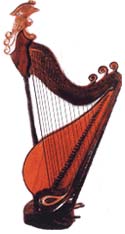Chinese ethnic instruments > Erhu - Chinese violin
Wednesday, July 22, 2009
The purpose of making music
Why do people make music?People make music either as a living or as a hobby. Sometimes people create music as a way of expressing themselves. Mankind uses music to express and convey feelings and to develop a feeling of togetherness. Different social groups have their own songs that give them an identity: the socialists have the socialist international, soccer and football clubs have their songs, nations have anthems. Music may express sadness, love, loneliness, happiness and so on, and so conveys those feelings to other people. Some languages in Africa and the Chinese language use melody to differentiate between meanings, thus the border between music/melody and speech only is not always clear. Music consists of rhythm and melody; dancing goes according to the rhythm and singing according to the melody.
Is the music made for entertainment?
Music is made for entertainment to some people, while others make music as a living.
Is the music used as an accompaniment for a dance?
Music is used as an accompaniment for a dance. They usually dance to the music during special occasions.
Is the music a part of everyday life?
The music is played more often on special occasions. However, it can also be played in everyday lives.
Tuesday, July 14, 2009
The musical features (CONT')
The sounds of India are warm and earthy...just like the people. They are a gregarious lot and their music echoes the multiplicity, that is India. The same diversity can be found in the various genres of music in this country. Classical music, the beats of Bhangra, the strains of Sufi music, Indo-jazz, Pop and Folk music---there is something for everyone.Source: http://www.idiscoverindia.com/Discover_India/music_india.html
Sunday, July 12, 2009
The musical features
What are some of the instruments used in the music?- Sitar
- Tabla
-Shehnai
How are the musical instruments played?
SITAR:
You can play the instrument by pulling the strings at the side. String instruments are probably the most popular instruments in India. String instruments have gained popularity because strings are considered to be the best accompaniment to singing, a prime element of Indian music.
TABLA:
The tabla is a very popular percussion instrument of India. It consists of two drums called tabla & dagga (bayan) respectively. The treble drum (tabla) is generally made of wood and the top is covered with a stretched skin. To produce the distinct treble sound of the tabla; the artesan has to make a hard mixture in the center of the tabla ( shahi ). The skin is wrapped around the wood frame with the help of leather strings (wadi ) and round wooden blocks (gatta). The tuning is done with the help of a hammer which is struck on the gatta to tense or relax the skin. The dagga pot is generally made of brass or copper. It is the bass accompaniment of the Tabla. The tabla is about 11 inches long while the dagga is about 10 inches long. To play the instrument, beat on the stretched skin of the drum.
SHEHNAI:
The shehnai belongs to the woodwind family of instruments. It has double reeds to produce that characteristic vibrating sound. It is played with the fleshy parts of the fingers rather than the tips of the fingers. The shehnai is capable of producing a sound very similar to the human voice.
The people who make music
From what country do these people come from?These people come from india.
These people stated above are those who help out in music in parts of India.
What kind of lifestyle do these people lead?
The people in India that makes music lead a life filled with music. They spend time trying to make their people enjoy the same form of music and hoping that they will like it. They believe that the essence of holiday celebrations lies in the traditional music.
Sources: http://www.rolfkillius.com/tmi.html,
http://www.tribuneindia.com/2009/20090311/ttlife.htm


